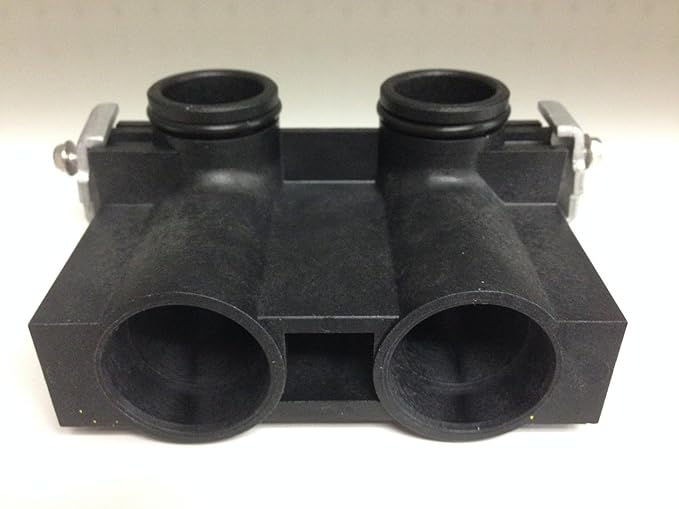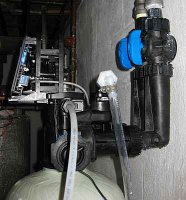Eljay
New Member
A Fleck 5600sxt was purchased a couple of weeks back and will finally be arriving soon. I've been indecisive about how it should be installed. Quotes in the $300-400 range by local professionals had me considering doing it myself. As this would be the first time sweating copper, I thought I might get torch and a handful of copper fittings to practice with. I'd also considering using flexible hoses due to their low relative cost--compared to getting Bernzomatic TS8000 torch, MAPP tank, flux, solder, other necessary tools, etc.--and ease of installation.
------------------------------------------------------
Questions regarding using flexible lines:
1. When routing the flexible hoses, what is the minimum loop radius without compromising the connection ends, "necks" and hoses themselves? How close to the connection points can you safely start bending them? I've searched specs and product pages using "bend", "bent", and "loop" to no avail.
The Fleck 5600sxt will be installed in the garage replacing a Culligan Medalist. Space is a concern. The existing softener's copper pipe extends out from the wall about 8". My hope is to cut the copper right behind the existing bypass enabling me to retain the inlet shutoff. However I don't think retaining the shutoff is absolutely necessary since there is another one in the garage upstream just 10 feet away.
If I were remove the original pipe and shutoff for a more compact installation, I'd be forced to cut closer to the drywall than I'm comfortable with due to the proximity of the nearest fitting. Whatever the approach, pushing the installation more than two feet or so from the wall might be too much. The media tank is 8" in diameter.
2. 18" or 24" flexible hoses?
The old copper terminates (perpendicular to the wall) about 8" below where the new bypass will sit. Is being longer generally better so as not to make any necessary turns/loops too tight? I assume between the two, any difference in flow is trivial. So should I get 24" hoses?
3. Sharkbite (SS3094FLEX24LF) or Falcon by John Guest (PTC1JG)?
Sharkbite is much easier to get my hands on though Home Depot and is cheaper in cost. Reviews indicate that they have problems when used to connect water heaters since internal rubber parts deteriorate and leach into the hot water downstream. This is a concern since--due to living in the desert southwest--it is common during the summertime for my cold water to run warm for several seconds before cooling down. It seems like the main water line is shallow enough underground that heat from unrelenting sunlight causes a non-trivial amount of heat transfer. I don't believe the temperature is as warm as a typical water heater gets. I'm sure it's below 120 F. Certainly below 140 F. Should I be worried?
Searching through older threads on this forum, John Guest hoses seem to be well regarded. Though they are costlier and must be ordered online. They also have a bypass side nylon FIP connection whereas the Sharkbite is steel. The ordered bypass is an original Fleck stainless steel model requiring the use of a brass nipple. I assume that the Sharkbite steel FIP connection would be superior in this case? I will use tape and thread sealant.
------------------------------------------------------
I've spent a good deal of time reading up on sweating copper on this forum, on copper.org, and watching Youtube. I'm confident I could get it to work eventually without burning the house down. I mainly get nervous about soldering near the bypass or ball valve but am sure there are ways around it. When it comes down to it, it's likely that my initial attempt(s) would leak increasing time and/or cost with main water shutoff to the entire house. So the cheaper/lazier side of me is currently winning out.
Edit: grammar and links
------------------------------------------------------
Questions regarding using flexible lines:
1. When routing the flexible hoses, what is the minimum loop radius without compromising the connection ends, "necks" and hoses themselves? How close to the connection points can you safely start bending them? I've searched specs and product pages using "bend", "bent", and "loop" to no avail.
The Fleck 5600sxt will be installed in the garage replacing a Culligan Medalist. Space is a concern. The existing softener's copper pipe extends out from the wall about 8". My hope is to cut the copper right behind the existing bypass enabling me to retain the inlet shutoff. However I don't think retaining the shutoff is absolutely necessary since there is another one in the garage upstream just 10 feet away.
If I were remove the original pipe and shutoff for a more compact installation, I'd be forced to cut closer to the drywall than I'm comfortable with due to the proximity of the nearest fitting. Whatever the approach, pushing the installation more than two feet or so from the wall might be too much. The media tank is 8" in diameter.
2. 18" or 24" flexible hoses?
The old copper terminates (perpendicular to the wall) about 8" below where the new bypass will sit. Is being longer generally better so as not to make any necessary turns/loops too tight? I assume between the two, any difference in flow is trivial. So should I get 24" hoses?
3. Sharkbite (SS3094FLEX24LF) or Falcon by John Guest (PTC1JG)?
Sharkbite is much easier to get my hands on though Home Depot and is cheaper in cost. Reviews indicate that they have problems when used to connect water heaters since internal rubber parts deteriorate and leach into the hot water downstream. This is a concern since--due to living in the desert southwest--it is common during the summertime for my cold water to run warm for several seconds before cooling down. It seems like the main water line is shallow enough underground that heat from unrelenting sunlight causes a non-trivial amount of heat transfer. I don't believe the temperature is as warm as a typical water heater gets. I'm sure it's below 120 F. Certainly below 140 F. Should I be worried?
Searching through older threads on this forum, John Guest hoses seem to be well regarded. Though they are costlier and must be ordered online. They also have a bypass side nylon FIP connection whereas the Sharkbite is steel. The ordered bypass is an original Fleck stainless steel model requiring the use of a brass nipple. I assume that the Sharkbite steel FIP connection would be superior in this case? I will use tape and thread sealant.
------------------------------------------------------
I've spent a good deal of time reading up on sweating copper on this forum, on copper.org, and watching Youtube. I'm confident I could get it to work eventually without burning the house down. I mainly get nervous about soldering near the bypass or ball valve but am sure there are ways around it. When it comes down to it, it's likely that my initial attempt(s) would leak increasing time and/or cost with main water shutoff to the entire house. So the cheaper/lazier side of me is currently winning out.
Edit: grammar and links
Last edited:





